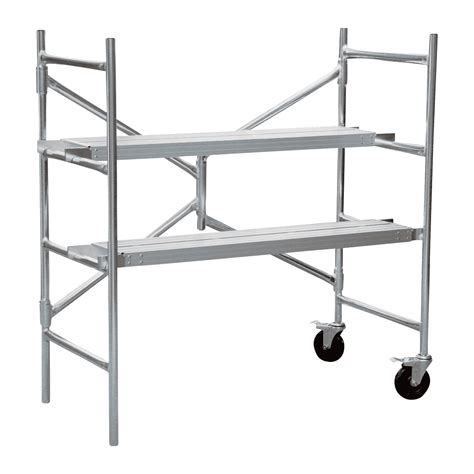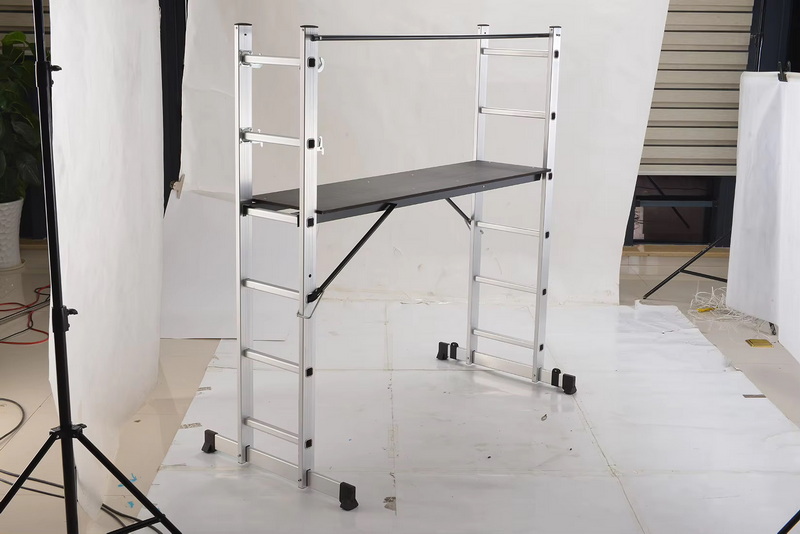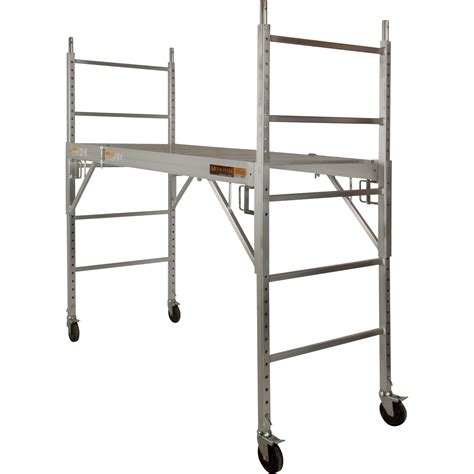Content Menu
● What to Consider When Buying Aluminum Scaffolding
>> 1. Material Quality
>> 2. Load Capacity
>> 3. Stability and Balance
>> 4. Safety Features
>> 5. Compliance with Regulations
● Practical Tips for Purchasing Aluminum Scaffolding
>> Assess Your Project Requirements
>> Check the Quality and Features
>> Research the Provider
>> Inquire About Training and Support
>> Consider Used Scaffolding Options
● Renting vs. Buying Aluminum Scaffolding
>> When to Rent
>> When to Buy
● Comparison: Aluminum vs. Steel Scaffolding
● Safety Standards for Aluminum Scaffolding
● Finding Aluminum Scaffolding for Sale Near Me
● Conclusion
● FAQ
>> 1. What are the key factors to consider when buying aluminum scaffolding?
>> 2. How does aluminum scaffolding compare to steel scaffolding in terms of weight and corrosion resistance?
>> 3. What safety features should I look for in aluminum scaffolding?
>> 4. Is renting or buying aluminum scaffolding more cost-effective?
>> 5. What certifications should I look for to ensure compliance with safety standards?
● Citations:
When searching for aluminum scaffolding for sale near me, selecting the right quality scaffolding is crucial for ensuring safety, efficiency, and cost-effectiveness in construction and maintenance projects. Aluminum scaffolding is favored for its lightweight nature, corrosion resistance, and ease of assembly compared to traditional steel scaffolding. This article provides a comprehensive guide on how to choose quality aluminum scaffolding, including factors to consider, safety standards, and practical tips for purchasing or renting scaffolding systems. We will cover essential aspects such as understanding material grades, assessing load-bearing capabilities, and evaluating safety features to help you make an informed decision.

What to Consider When Buying Aluminum Scaffolding
1. Material Quality
High-quality aluminum is essential for durability and safety. Look for scaffolding made from high-strength aluminum alloys, such as 6061-T6 or 6063-T5, that resist corrosion and bending. These alloys offer excellent strength-to-weight ratios, ensuring the scaffolding can withstand heavy loads without compromising its integrity. Ensure the material specifications are detailed and meet industry standards[2]. Ask for mill certifications to verify the alloy's composition and strength.
2. Load Capacity
Calculate the load capacity needed based on the number of workers, tools, and materials that will be on the scaffold. Consider the heaviest possible load the scaffolding might bear. Ensure the scaffolding can support at least four times the intended load, as required by OSHA standards. Look for scaffolding with clearly marked load capacity ratings on each component.
3. Stability and Balance
Choose scaffolding with robust base plates, stabilizers, and locking mechanisms to ensure stability. The base plates should be wide enough to distribute the load evenly on the ground, and the stabilizers should extend outward to prevent tipping. Locking mechanisms on the wheels or casters are essential for preventing movement during use. Even lightweight aluminum scaffolding can maintain excellent balance with these features. Scaffolding should also have adjustable legs to compensate for uneven ground surfaces.
4. Safety Features
Ensure the scaffolding includes essential safety features such as guardrails, non-slip platforms, and secure joints. Guardrails should be installed on all open sides of the platform to prevent falls. Non-slip platforms made from textured aluminum or plywood with a non-slip coating are crucial for preventing slips and trips. Secure joints and connections are essential for maintaining the structural integrity of the scaffolding. Anti-slip rungs on ladders are also crucial for preventing accidents. Toe boards are also a crucial safety feature to prevent tools and materials from falling off the platform.
5. Compliance with Regulations
Verify that the scaffolding meets local and international safety standards. Look for certifications from reputable organizations such as OSHA or ANSI. These certifications indicate that the scaffolding has been tested and meets specific safety requirements. Ask the provider for documentation of compliance and safety testing.
Practical Tips for Purchasing Aluminum Scaffolding
Assess Your Project Requirements
Consider factors like project duration, height, and weight capacity. Determine if you need additional features such as adjustable heights or wheels for mobility. For example, mobile scaffolding is ideal for projects requiring frequent movement, while stationary scaffolding is better suited for tasks in a fixed location. Also consider the terrain and whether you'll need special base plates or leveling feet.
Check the Quality and Features
Inspect the build quality of the scaffolding and its components. Look for aluminum scaffolding ladders with anti-slip features and sturdy designs. Examine the welds and connections for any signs of weakness or damage. Test the locking mechanisms to ensure they function properly. Check the platform for any signs of wear or damage.
Research the Provider
Work with reputable providers who offer well-maintained equipment and good customer service. Check for customer reviews and ask about maintenance practices. A reliable provider should offer thorough inspections and maintenance to ensure the scaffolding is in safe working condition. Also, ask about their return or exchange policies in case you encounter any issues with the scaffolding. It's always a good idea to visit their physical location if possible, especially when searching for aluminum scaffolding for sale near me, to assess the condition of their inventory firsthand.
Inquire About Training and Support
Some providers offer training on the safe use and assembly of aluminum scaffolding. This can be particularly helpful for those who are new to scaffolding. Ask about available training programs and ongoing technical support.
Consider Used Scaffolding Options
If you are on a tight budget, consider purchasing used aluminum scaffolding. However, be sure to thoroughly inspect the scaffolding for any signs of damage or wear before purchasing. Used scaffolding should still meet all relevant safety standards. You may find some excellent deals when looking for aluminum scaffolding for sale near me from companies upgrading their equipment.

Renting vs. Buying Aluminum Scaffolding
When to Rent
Renting is ideal for short-term projects, budget constraints, or temporary needs. It provides a cost-effective solution without long-term investment. Renting also eliminates the need for storage and maintenance. Look for rental companies that offer well-maintained equipment and flexible rental terms.
When to Buy
Buying is more economical for long-term use or frequent projects. Owning scaffolding allows customization and adaptation to specific project requirements. Buying also gives you greater control over the quality and maintenance of the scaffolding. Before buying, consider the long-term storage requirements and ongoing maintenance costs. When searching for aluminum scaffolding for sale near me, factor in transportation costs from the supplier to your job site.
Comparison: Aluminum vs. Steel Scaffolding
| Feature | Aluminum Scaffolding | Steel Scaffolding |
| Weight | Lightweight and portable | Heavier and more cumbersome |
| Corrosion Resistance | Naturally corrosion-resistant | Prone to rust without treatment |
| Load Capacity | Supports heavy loads with proper setup | Comparable but heavier |
| Assembly Ease | Quick assembly with locking clamps | Slower due to heavy components |
| Maintenance | Low maintenance due to corrosion resistance | Requires regular maintenance |
| Longevity | Longer lifespan outdoors | Shorter lifespan if exposed to elements |
| Cost | Generally More Expensive Initially | Generally Less Expensive Initially |
| Transportation | Easier and Less Expensive | More Difficult and Expensive |
Safety Standards for Aluminum Scaffolding
- Fall Protection: Use guardrails and personal fall arrest systems for workers above 10 feet. This includes harnesses, lanyards, and lifelines.
- Guardrail Height: Ensure guardrails are at least 38 inches high. Midrails should also be installed halfway between the top rail and the platform.
- Base Plates: Use level base plates capable of supporting the entire load. The base plates should be placed on a solid, level surface.
- Load Capacity: Ensure scaffolding supports at least four times the intended load. Do not exceed the maximum load capacity specified by the manufacturer.
- Proper Assembly: Follow the manufacturer's instructions carefully when assembling the scaffolding. Ensure all connections are secure.
- Regular Inspections: Inspect the scaffolding regularly for any signs of damage or wear. Replace any damaged components immediately.
Finding Aluminum Scaffolding for Sale Near Me
When searching for aluminum scaffolding for sale near me, start with online directories like Google Maps, Yelp, and industry-specific websites. Read customer reviews and compare prices from different suppliers. Consider visiting local construction supply stores to see the scaffolding in person before making a purchase. Local rental companies may also offer used scaffolding for sale. Check online marketplaces like Craigslist or Facebook Marketplace, but exercise caution and thoroughly inspect the scaffolding before buying.
Conclusion
Choosing quality aluminum scaffolding for sale near me involves careful consideration of material quality, load capacity, stability, safety features, and compliance with regulations. Aluminum scaffolding offers numerous advantages, including lightweight portability, corrosion resistance, and ease of assembly, making it an excellent choice for various construction and maintenance projects. By following the guidelines outlined in this article and adhering to safety standards, you can ensure a safe, efficient, and cost-effective scaffolding solution for your needs. Always prioritize safety, quality, and reliability when selecting aluminum scaffolding.

FAQ
1. What are the key factors to consider when buying aluminum scaffolding?
Key factors include material quality, load capacity, stability features, safety features, and compliance with safety regulations. Also, consider the project requirements, provider reputation, and available training and support.
2. How does aluminum scaffolding compare to steel scaffolding in terms of weight and corrosion resistance?
Aluminum scaffolding is lighter and more corrosion-resistant than steel, making it easier to transport, assemble, and maintain.
3. What safety features should I look for in aluminum scaffolding?
Essential safety features include guardrails, non-slip platforms, secure joints, anti-slip rungs on ladders, and toe boards.
4. Is renting or buying aluminum scaffolding more cost-effective?
Renting is ideal for short-term projects, while buying is more economical for long-term use or frequent projects. Consider the project duration, storage requirements, and maintenance costs when making your decision.
5. What certifications should I look for to ensure compliance with safety standards?
Look for certifications from reputable organizations such as OSHA or ANSI to ensure compliance with local and international safety standards. Ask the provider for documentation of compliance and safety testing.
Citations:
[1] https://ppl-ai-file-upload.s3.amazonaws.com/web/direct-files/43276041/3ad805ce-4222-4718-969c-539dac2fee0a/paste-1.txt
[2] https://ppl-ai-file-upload.s3.amazonaws.com/web/direct-files/43276041/64f7d917-6ac1-427a-aa1d-25993b592f22/paste-1.txt






















